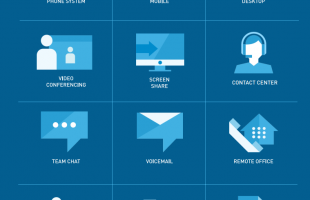Communications
The business communications landscape has transformed dramatically over the past decade. While VoIP phone systems revolutionized how companies handle voice calls, Unified Communications as a Service (UCaaS) has taken connectivity to the next level, combining voice, video, messaging, and collaboration tools in one integrated platform.
If your business is evaluating phone system options, understanding the difference between traditional VoIP and UCaaS is key to choosing the right solution for your team, budget, and long-term goals.
What Is Traditional VoIP?
Voice over Internet Protocol (VoIP) allows businesses to make and receive phone calls through an internet connection instead of traditional phone lines. VoIP converts analog voice signals into digital data packets that travel over the web.
Traditional VoIP systems primarily focus on voice communication, offering features such as:
• Call forwarding and routing
• Voicemail to email
• Auto-attendants
• Conference calling
• Call recording
• Extension dialing
Compared to landline phones, VoIP provides more flexibility and can cut monthly phone costs down by a lot. It’s ideal for organizations that rely heavily on phone communication but don’t require advanced collaboration features.
However, as teams increasingly rely on video meetings, instant messaging, and file sharing, many businesses find themselves juggling separate apps for each purpose. That’s where UCaaS comes in.
What Is UCaaS (Unified Communications as a Service)?
Unified Communications as a Service (UCaaS) represents the next generation of business communication technology. While VoIP focuses on voice, UCaaS integrates multiple tools into one cloud-based platform, including:
• Voice and video calling
• Instant messaging and team chat
• File sharing and screen sharing
• SMS and text messaging
• Presence indicators
• Integration with business applications
UCaaS platforms don’t just offer these features, they unify them. Users can switch from a phone call to a video meeting or group chat without changing applications or losing context.
Think of traditional VoIP as a smart phone system. UCaaS is a complete communication ecosystem designed for how today’s hybrid teams actually work.
Key Differences Between UCaaS and Traditional VoIP
1. Scope of Communication Tools
Traditional VoIP delivers reliable voice communication but depends on separate apps for video or messaging. UCaaS combines everything—voice, video, chat, and collaboration—into a single dashboard.
2. User Experience and Workflow
With traditional VoIP, employees often switch between multiple tools throughout the day, phone systems for calls, apps like Zoom for video, and Slack for chat.
UCaaS streamlines that workflow with a consistent user experience across all devices. Presence indicators show who’s available, and conversation history follows users between modes, whether it’s a chat, call, or meeting. This consistency is especially valuable for remote and hybrid teams.
3. Mobility and Device Flexibility
Both VoIP and UCaaS support mobile use, but UCaaS takes it further. Its mobile apps provide full access to calls, messaging, video, and collaboration tools, all synced with the desktop experience. Employees can start a call at their desk, continue the discussion via chat on a laptop, and join a video meeting from their phone without losing context.
4. Integration Capabilities
Modern businesses rely on software like Salesforce, Google Workspace, Microsoft Outlook, and Zendesk. Traditional VoIP systems may offer limited integration (like click-to-dial), while UCaaS platforms deeply integrate with your tech stack, automating workflows, syncing contacts, and logging interactions across applications.
Our managed VoIP services at Document Solutions include these integration capabilities, ensuring your communication platform supports your business operations, not the other way around.
5. Scalability and Management
Both systems scale, but in different ways. Traditional VoIP easily adds lines or users. UCaaS, on the other hand, scales both users and functionality, allowing you to enable new communication features as your business grows, without investing in separate systems.
6. Cost Structure
VoIP typically offers lower upfront costs per user, but you may need to pay separately for conferencing, messaging, or file-sharing apps. UCaaS, while slightly higher per user, often provides a lower total cost of ownership because it consolidates all communication tools into one platform, reducing IT overhead and third-party software expenses.
Which Solution Is Right for Your Business?
Traditional VoIP Makes Sense When:
• Your communication needs are primarily voice-based
• You already use other collaboration tools (like Teams or Zoom)
• Budget constraints are a top priority
• Your workforce is mostly office-based
UCaaS Is the Better Choice When:
• You support remote or hybrid work models
• Your team relies heavily on video meetings and chat
• You’re tired of managing multiple communication tools
• You want deep integration with CRM or helpdesk platforms
• You’re planning for business growth
Making the Transition from VoIP to UCaaS
Transitioning from a traditional VoIP system to UCaaS is easier than many expect. To ensure a successful rollout:
1. Assess your communication needs.
2. Plan for adoption.
3. Evaluate your network.
4. Review compliance and security.
Ready to Modernize Your Business Communications?
Whether you’re looking for traditional VoIP or a comprehensive UCaaS solution, Document Solutions helps businesses simplify communication, boost productivity, and reduce costs.
With nearly 30 years of experience, we deliver enterprise-grade technology with personalized, local service. Call (888) 880-3377 or contact us here to learn more about our VOIP and UCaaS systems!





